The Institute for Security Policy and Law’s portfolio of books, white papers, working papers, and other publications cover a spectrum of topics, including emerging technology, national and international security, counterterrorism, geopolitics, homeland security, veterans affairs, postconflict reconstruction, and humanitarian law.
- Books & Monographs
- Working Papers, White Papers, & Dissertations
- Army War College Reports
- Symposium Proceedings
Books & Monographs
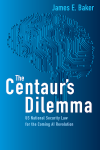 |
The Centaur’s Dilemma—National Security Law for the Coming AI RevolutionThe Hon. James E. Baker The increasing use of artificial intelligence poses challenges and opportunities for nearly all aspects of society, including the military and other elements of the national security establishment. This book addresses how national security law can and should be applied to artificial intelligence, which enables a wide range of decisions and actions not contemplated by current law. Written in plain English, The Centaur’s Dilemma will help guide policymakers, lawyers, and technology experts as they deal with the many legal questions that will arise when using artificial intelligence to plan and carry out the actions required for the nation’s defense. |
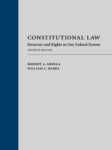 |
Constitutional Law: Structure and Rights in Our Federal System, 7th EditionEds. William C. Banks & Rodney A. Smolla (Carolina Academic Press, 2019) Traditional in scope, with full coverage of separation of powers, federalism, and individual rights, Constitutional Law emphasizes structural issues more so than many other constitutional law casebooks. Individual rights are discussed in context and within chapters focusing on traditional doctrinal categories, such as economic and social rights, rights of conscience and expression, and rights in the public arena. The seventh edition makes heavy use of contemporary constitutional conflicts to present in a vivid manner the cases and secondary material traditionally covered in comprehensive constitutional law courses, including case studies in issues such as gun control, problems on the special counsel investigation by Robert Mueller, the Supreme Court’s resolution of which branch controls recognition of Jerusalem in providing passports, and controversies surrounding the Affordable Care Act. |
 |
Soldiers on the Home Front: The Domestic Role of the American MilitaryBy William C. Banks & Stephen Dycus (Harvard, 2016) When crisis requires American troops to deploy on American soil, the country depends on a rich and evolving body of law to establish clear lines of authority, safeguard civil liberties, and protect its democratic institutions and traditions. Since the attacks of 9/11, the governing law has changed rapidly even as domestic threats—from terror attacks, extreme weather, and pandemics—mount. Soldiers on the Home Front is the first book to systematically analyze the domestic role of the military as it is shaped by law, surveying America’s history of judicial decisions, constitutional provisions, statutes, regulations, military orders, and martial law to ask what we must learn and do before the next crisis. |
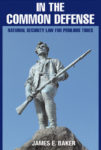 |
In the Common Defense: National Security Law for Perilous TimesBy the Hon. James E. Baker (Cambridge, 2014) The threat of terrorism places U.S. national security police at the crossroads of security and liberty. This book focuses on the legal issues surrounding the war on terror. This book is essential reading for anyone who wants an honest review of the law and an accessible understanding of how law relates to U.S. national security. This is also a book about national security government and why it is dependent on good process and the moral integrity of those who wield its power. This is at heart a book about the process and practice of government and what we should mean when we refer to “good government.” |
 |
New Battlefields/Old Laws: Critical Debates on Asymmetric WarfareEdited by William C. Banks (Columbia, 2014) Recognizing that many of today’s conflicts are low-intensity, asymmetrical wars fought between disparate military forces, Banks’s collection analyzes non-state armed groups and irregular forces (such as terrorist and insurgent groups, paramilitaries, child soldiers, civilians participating in hostilities, and private military firms) and their challenge to international humanitarian law. |
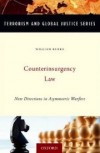 |
Counterinsurgency Law: New Directions in Asymmetric WarfareEdited by William C. Banks (Oxford, 2013) Addressing the considerable challenges for the future of armed conflict, each contributor in the book explores the premise that in COIN operations, international humanitarian law, human rights law, international law more generally, and domestic national security laws do not provide adequate legal and policy coverage and guidance for multiple reasons, many of which are explored in this book. A second shared premise is that these problems are not only challenges for the law in post-9/11 security environments-but matters of policy with implications for the international community and for global security more generally. |
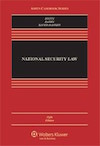 |
Counterterrorism Law, 4th EditionBy William C. Banks, Stephen Dycus, Peter Raven-Hansen, & Stephen Vladeck (Wolters Kluwer, 2020) Recent judicial rulings, legislative initiatives, and executive reforms are prominently featured in the Fourth Edition of Counterterrorism Law. The additional rulings and updates to this edition help refine our understanding of relevant government structures, processes, and institutions, and they raise critically important new questions. They also address new threats and breathtaking advances in technology.
|
 |
National Security Law, 7th EditionBy William C. Banks, Arthur L. Berney, Stephen Dycus, Peter Raven-Hansen, & Stephen Vladeck, (Aspen, 2020) For the last 30 years, National Security Law has helped create and shape an entire new field of law. It has been adopted for classroom use at most American law schools, all of the military academies, and many non-law graduate programs. The Seventh Edition of this leading casebook provides an up-to-date, user-friendly survey of this extremely dynamic field. |
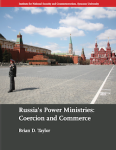 |
Russia’s Power Ministries: Coercion & CommerceBy Brian D. Taylor, SPL Monograph (October 2007) Russian President Vladimir Putin has increased the power and resources of Russia’s power ministries – military, security, and law enforcement agencies. He also has empowered many political allies with backgrounds in these structures, placing them in important positions throughout the state, and in state-owned businesses. Corrupt and inefficient Russian power ministries potentially threaten US foreign and security interests, particularly in terms of nonproliferation and transnational crime and terrorism. The US should continue to cooperate where possible with Russia on important security interests, but must be aware of how the “commercialization” of the power ministries affects their behavior and complicates joint projects. |
Working Papers/White Papers/Dissertations
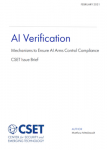 |
Mechanisms to Ensure AI Arms Control ComplianceBy Matthew Mittelstaedt, SPL AI Policy Fellow The rapid integration of artificial intelligence into military systems raises critical questions of ethics, design and safety. While many states and organizations have called for some form of “AI arms control,” few have discussed the technical details of verifying countries’ compliance with these regulations. This brief offers a starting point, defining the goals of “AI verification” and proposing several mechanisms to support arms inspections and continuous verification. |
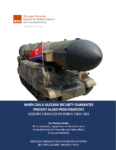 |
When Can a Nuclear Security Guarantee Prevent Allied Proliferation?By Whitney Baillie, Ph.D. Candidate, Maxwell School The purpose of this study was to draw some preliminary conclusions about the factors that influence the credibility of U.S. nuclear security guarantees and consequently their effectiveness as a nonproliferation tool. It is not just a matter of whether nuclear security guarantees prevent U.S. allies from proliferating. Rather, I investigated the policy choices surrounding these guarantees that affect U.S. allies’ perceptions of the credibility of the guarantee. This is imperative because only a credible nuclear security guarantee can serve as a viable substitute for a country’s own nuclear arsenal, especially when they face a grave security threat. Andrew Berlin Family National Security Research Fund |
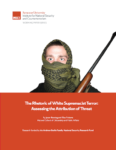 |
The Rhetoric of White Supremacist Terror: Assessing the Attribution of ThreatBy Jason Blessing and Elise Roberts, Ph.D. candidates, Maxwell School In the post-9/11 world, fears of terrorism have led to growing anti-immigration sentiments among the public and calls for stricter national security measures. While recent studies have successfully discredited the general theory that immigration increases the risk of terrorist infiltration (Bove & Bohmelt, 2016), authors have largely ignored the terrorists next door. Domestic terrorism remains widely understudied (Simi, 2010); however, the threat is just as potent and pervasive as the danger posed by international actors. Andrew Berlin Family National Security Research Fund |
 |
UN Mediation and the Women, Peace, and Security Agenda: Moving from Rhetoric to RealityBy Catriona Standfield, Ph.D. Candidate, Maxwell School Women are present on the frontlines of conflict as combatants, peacebuilders, victims, and more. Yet, when it comes to negotiating the peace they are conspicuously absent, meaning their needs often go ignored. Andrew Berlin Family National Security Research Fund |
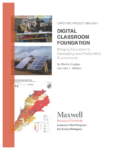 |
Digital Classroom Foundation: Bringing Education to Developing and PostConflict EnvironmentsBy Mireille Koukjian & John L. Williams (Lebanon Pilot Program for Syrian Refugees, SU Maxwell School) Education disruption impacts generations in postconflict societies and developing nations leaving youth unprepared for the labor market, unable to fully participate in civil society reconstruction, and susceptible to return to conflict. Education in post-conflict societies and refugee camps is often impacted by poorly trained teachers, classroom overcrowding, corruption and security issues, and travel distances. The Digital Classroom Foundation (DCF) intends to develop a pilot program, which mitigates the above-identified issues, for Syrian refugees residing in Lebanon. |
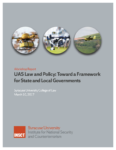 |
UAS Law and Policy: Toward a Framework for State and Local Governments (Workshop Report), May 2017Syracuse University’s Institute of National Security and Counterterrorism (SPL) hosted a one-day workshop on the law and policy of Unmanned Aerial Systems (UAS or “drone”) on March 10, 2017. SPL selected two topics at the forefront of UAS law and policy development:
|
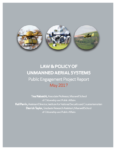 |
Law & Policy of UAS Public Engagement Project Report, May 2017On March 26, 2017, more than 40 residents from the Syracuse, NY area attended a three-hour public workshop to evaluate and discuss perspectives and policy options surrounding the use of Unmanned Aerial Systems (UAS, or “drones”) in the community. This deliberative public workshop shed light on how an informed public views issues relating to the use of UAS. |
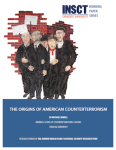 |
The Origins of American CounterterrorismBy Michael Newell, Ph.D. Student, SU Maxwell School, SPL Working Paper 2016 (research funded by the Andrew Berlin Family National Security Fund) While much attention has been paid to the American state’s reaction to the Sept. 11, 2001, attacks, the origins of institutions and ideas deployed in the War on Terror in historical conceptions of terrorism and political violence have been overlooked. In this paper, I analyze these historical origins through the American state’s response to Ku Klux Klan (KKK), Irish-American Fenian, and anarchist political violence from the end of the Civil War in 1865 until the 1920 bombing of Wall Street, the last alleged significant act of anarchist violence. I argue that this history demonstrates a process of threat construction and changes in institutions, laws, and policies. These changes came about through a mixture of complex social and political factors, but the perception of threat significantly influenced their content and the populations they were directed against. Andrew Berlin Family National Security Research Fund |
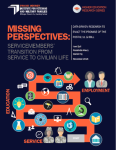 |
Missing Perspectives: Servicemembers’ Transition from Service to Civilian LifeBy Corri Zoli, Rosy Maury, Danny Faye, & Nick Armstrong, Institute for Veterans and Military Families (IVMF) Higher Education Research Series 2015 (research funded by Google, IVMF, and others) Developed with generous support from a Google Global Impact Award and in dialogue with our partners—the Student Veterans of America (SVA), the Posse Foundation, and the Veterans of Foreign Wars (VFW)—this summary report uses an interdisciplinary, data-driven approach to understand how today’s Post-9/11 military servicemembers are faring in their transition processes, especially in higher education. |
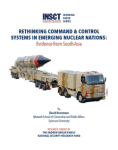 |
Rethinking Command & Control Systems in Emerging Nuclear Nations: Evidence from South AsiaBy David Arceneaux, Ph.D. Student, SU Maxwell School, SPL Working Paper 2015 (research funded by the Andrew Berlin Family National Security Fund) When evaluating emerging nuclear powers, researchers often devote attention to the quantity and quality of a state’s physical nuclear arsenal while overlooking command and control structures. These measures of nuclear capacity, however, are more useful for generating estimates of a state’s nuclear intentions than accounting for how a nuclear state’s organizations might operate in practice. Any explanation of how these states operate in practice must account for the role of command and control. By explaining the factors that affect command and control systems within emerging regional nuclear states, researchers can better understand the practical employment of nuclear capabilities, which offers insight into how destabilizing future proliferators may be for regional and global security. Andrew Berlin Family National Security Research Fund |
 |
The Prospects of Institutional Transfer: A Within-Case Study of NATO Advisor Influence Across the Afghan Security Ministries and National Security Forces, 2009-2012By Nicholas J. Armstrong, Ph.D. Dissertation 2014 This dissertation is an in-depth case study of NATO advisors and their perceived influence in Afghanistan (2009-2012). It explores the two-part question, how do foreign security actors (ministerial advisors and security force trainers, advisors, and commanders) attempt to influence their host-nation partners, and what are their perceptions of these approaches on changes in local capacity, values, and security governance norms? I argue that security sector reform (SSR) programs in fragile states lack an explicit theory of change that specifies how reform occurs. From this view, I theorize internationally led SSR as “guided institutional transfer,” grounded in rationalist and social constructivist explanations of convergence, diffusion, and socialization processes. |
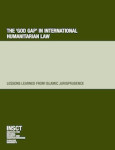 |
The “God Gap” in International Humanitarian Law: Lessons Learned from Islamic JurisprudenceBy Corri Zoli, SPL Working Paper (January 2012) This essay bridges security and legal studies to show how contemporary debate over humanitarian legal norms today in both Islamic and international law traditions is a response to tectonic shifts in global conflict patterns now occurring in the post 9/11 security environment. If these shifts have helped raise these legal norms and their gaps to new heights of global discussion, this reflexive moment is overwhelmingly positive—provided that such attention, particularly in the Islamic context, is framed in ways adequate to the complexity of our changing international security environment. |
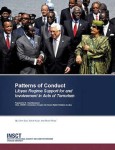 |
Patterns of Conduct: Libyan Regime Support for and Involvement in Acts of TerrorismBy C. Zoli, S. Azar, & S. Ross, UNHRC Commission of Inquiry into Human Rights Violations in Libya (2010) This Report provides a brief history and outline of documented examples of Libyan support, funding, and involvement in acts of terrorism and related international |
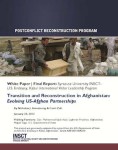 |
Transition and Reconstruction in Afghanistan: Evolving US-Afghan PartnershipsBy C. Zoli & N. Armstrong, Kabul International Visitor Leadership Program Report (January 2012) This report provides an overview of SPL’s US Department of State/US Embassy-Kabul International Visitor Leadership Program, which provided the Afghan Governor of Laghman Province, Mohammad Iqbal Azizi, opportunities to experience first-hand examples of US democratic governance at the federal, state, and local levels and which exposed US academics and policymakers to an emergent Afghan leader’s approach and to perspectives about Afghan provincial transition and reconstruction processes. |
Army War College Reports
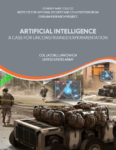 |
Artificial Intelligence: A Case for Unconstrained ExperimentationBy Col. Jacob J. Larkowich, SPL/Army War College Fellow 2019 Technological advances generating vast improvements in computer processing power, data storage capacity, and digital interconnectivity have raised the specter of an artificial intelligence (AI) arms race. AI has progressed from scientific and popular culture curiosity to direct military application. China and Russia have recently outlined long-term strategies or invested in research with the intent of surpassing the United States in the field within the coming decade. As with past military innovation, maintaining superiority in both the capability and its application is critical to continued U.S. military and strategic dominance. Though the U.S. has lagged behind key competitors in advancing a comprehensive development strategy, recent efforts to do so offer a window of opportunity to maintain the country’s lead in applied military use of artificial intelligence. Maintaining that lead in the U.S. Army requires an effort that bridges the boundaries between developers, experimentation, and the practitioners who will employ the technology. Past experience in applying emerging technology, like the Army’s General Headquarters Maneuvers in 1941, offer lessons the Army can leverage. |
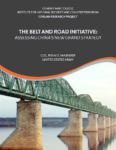 |
The Belt and Road Initiative: Assessing China’s New Grand StrategyBy Col. Ryan O. Maender, SPL/Army War College Fellow 2018 In 2013, China’s President Xi Jinping announced his vision for the “Silk Road Economic Belt’ and ‘Maritime Silk Road of the Twenty-First Century,’” which signaled the birth of China’s One Belt, One Road global infrastructure project. Officially named the Belt and Road Initiative (BRI) in 2015, when complete it will connect Europe, Asia, and Africa through one network of land and sea lanes, enabling efficient trade and flow of resources across 68% of the world’s land mass. Often seen as a purely economic program aimed at sustaining China’s growth, the BRI is a new grand strategy with an end-goal of achieving global superpower status, eclipsing the United States in all ways. US policymakers have been slow to study the BRI and how it challenges US national interests. US actions to date have been inconsistent, disjointed, and late in addressing China’s moves to assume a greater global role. In light of China’s new strategy, the United States Government (USG) must take actions to maintain American global influence and offset China’s gains, all while mitigating the risk of armed conflict. Historical examples like the Solarium Project serve as a template for developing a long-term, comprehensive strategy toward a rising China. |
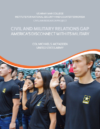 |
Civil and Military Relations Gap: America’s Disconnect with Its MilitaryBy COL Mike McFadden, SPL/Army War College Fellow 2017 Many scholars in the field of civilian and military relations focus on a gap between senior civilian and military leadership. In this paper, I will focus on that gap as it pertains to the American population and the disconnect that exists with the people who serve in our Armed Forces. Three significant factors are contributing to this disconnect; representation of the population in uniform, social and cultural gaps, and politics in military service. Narrowing the patterns we recruit affects the geographic and economic composition of our military members, distinguishing them from their civilian counterparts. From a cultural perspective, the norms of the military are often at odds with those of the younger generation, the very audience the military needs to target to maintain a viable force. Along with an unbalanced representation, the growing role of politics and the uniform has the potential to widen an already existing gap in the civil military relations in our nation. Closing the gap will require a reconsideration of the all-volunteer force, who and how we recruit, and how we are re-connecting our service members with society. |
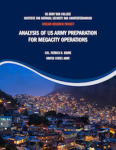 |
Analysis of US Army Preparation for Megacity OperationsBy COL Patrick Kaune, SPL/Army War College Fellow 2016 The United States US Army Chief of Staff Studies Group has identified the megacity as a future challenge to the security environment. Due to their complexity, megacities present a vulnerable and challenging future operational environment. Currently, however, the US Army is incapable of operating within the megacity. The US Army must think and learn through leveraging partnerships, which enhance institutional understanding. Historical experiences and lessons learned should assist in refining concepts and capabilities needed for the megacity. Continued leadership of an integrated joint scenario driven effort will inform future force organization and employment, and by utilizing a framework of Doctrine, Organization, Training, Materiel, Leadership, Personnel and Facilities (DOTMLPF), the US Army should prepare itself for the megacity challenge. The US Army paradigm of Think—Learn—Analyze—Implement paradigm should also aid in the preparation. |
 |
Modernizing Benefits: Supporting Veterans & the Federal BudgetBy LTC Patricia Hagen, SPL/Army War College Report 2015 During a time of dwindling resources and competing requirements, the future of our veterans’ care and benefits remains uncertain. It is our obligation as a nation to establish a strategy to ensure support for those who defend our freedom and protect our way of life. It is also our fiduciary responsibility to the American public to ensure this strategy is manageable given a fiscally constrained environment. This paper discusses issues of supporting an All Volunteer Force and also will provide a brief overview of the US Department of Veterans Affairs (VA) system’s current practices and trends in benefit claims. It then recommends possible courses of action with respect to military retirement and benefits reform as well as VA disability benefits. Ultimately, this paper advocates that a national policy must be implemented to benefit the military and our society as a whole. |
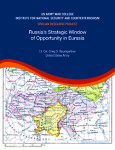 |
Russia’s Strategic Window of Opportunity in EurasiaBy LTC Craig Baumgartner, SPL/Army War College Report 2014 Events surrounding the European Union’s Eastern Partnership Summit in Vilnius, Lithuania in late November 2013 foreshadow what Eurasian states will experience in the coming decade. Ukraine’s pivot back to the east—coupled with Moldova, Georgia, and others always looking over their shoulders and Armenia’s abrupt end to considering the EU Association Agreement—begs the question: what key geostrategic factors are motivating these outcomes? Addressing this question—and its related contexts and causes—depends upon understanding the contemporary geostrategic reality facing Eurasia, and importantly, Russia’s and other influential players’ emerging political calculus. |
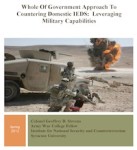 |
Whole Of Government Approach To Countering Domestic IEDS: Leveraging Military CapabilitiesBy COL Geoffrey Stevens, SPL/Army War College Report 2012 Shortfalls in current law, military doctrine, organizational structure, training and information sharing protocols are preventing an optimized and united, or “whole of government” approach to addressing the threat of an IED attack on US soil as called for in HSPD-19 and the National Security Strategy. This paper explores those shortfalls and recommends several solutions. Chief among them is establishment of a US Department of Defense counter-IED Joint Task Force (JTF) headquarters to facilitate improved response, training, and sharing of information from military Explosive Ordnance Disposal (EOD) forces in support of civil law enforcement authorities. |
Symposium Proceedings
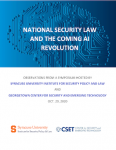 |
National Security Law and the Coming AI RevolutionObservations from a Symposium hosted by the Institute for Security Policy and Law and the Georgetown Center for Security and Emerging Technology Oct. 29, 2020 |
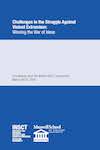 |
Challenges in the Struggle Against Violent Extremism: Winning the War of IdeasProceedings from the 2006 SPL-Bantle Symposium All the contributors to the Symposium share the view expressed by Bantle Professor Montgomery Meigs that successes in the struggle against violent extremism will occur only when government and the private sector combine forces. Business models and private sector leadership and management solutions will help develop the technologies and ideas that will support government in its ongoing efforts to combat extremist forces. |
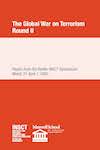 |
The War on Terrorism: Round IIProceedings from the 2005 SPL-Bantle Symposium The articles collected in this book build on presentations made by panelists at the symposium. They examine executive branch challenges in forming counterterrorism policy; dilemmas faced by governments in liberal democracies in countering terrorism; the composition, formation, and operation of groups involved in the global salafi jihad; and legal considerations in the war on terrorism especially concerning the use of coercive interrogation to obtain critical intelligence. |
